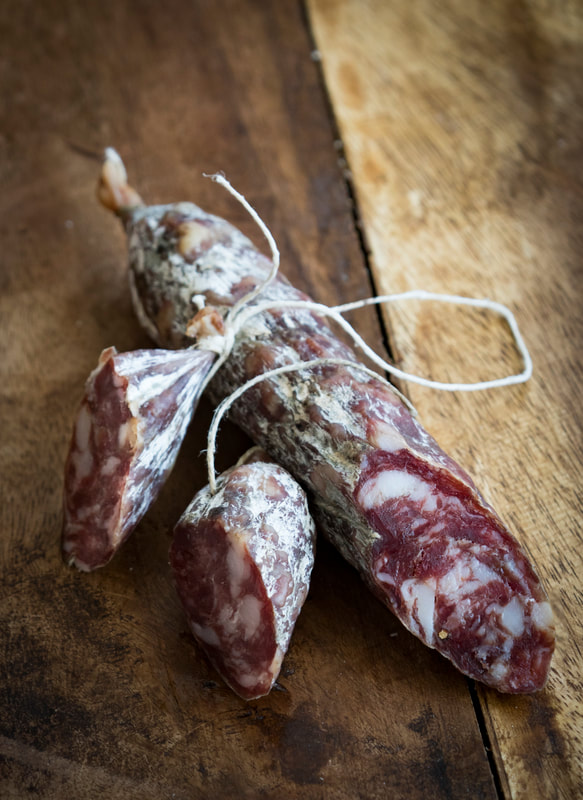|
What does it take to make a salame? Probably more than you can imagine (or want to imagine). You see, the job of the salumiere (the specialized butcher) contributes only in a small way to the flavor of the final product. In fact a good salumiere is humble because his/her work is only marginal compared to the work that the farmers put into the creation of the final product.
PRE-SALAME Making a salame starts in the barn, on cold winter mornings, usually when there is a storm and the experienced and patient sow works to get her piglets out, dry, fed and warm, while we (the human doulas) jump swiftly to remove the little ones from underneath mom in case they are in danger of being crashed. You see, the piglets need the warmth of the mom; they need to be at 100F, but in the winter in the barn is below zero. No matter how much hay and animals are in there, if outside there is -20F, it is too cold for them so they seek mom's warmth but by doing so they are very close to her and a good mom can keep track of 10 or 12 piglets but when it is 14+ it becomes impossible to know where they all are and being able to sit down safely or even turn around in her sleep. So we help out. Some farmers use heat boxes for their piglets but we found that our moms just need us for the first few hours and then at feeding time so we have our system. We also have the support of the hens that, for some reason unknown to me, they start hanging out in the pig pen when new piglets arrive and they watch over the kids, preventing them from wondering away when mom gets up to feed and drink. Salame is made in September of the year before, by the farmers on the tractor seeding the pastures with a combination of grasses, legumes and herbs that will become an essential part of the diet of the pigs when they will forage that area the year later. Salame is made in the hot mornings, in the rainy mornings, in the windy mornings, in the freezing mornings with a weed-wacker in one hand and a roll of wire in the pocket, as we make new paddocks. Salame is made with a bucket of food in one hand, running like crazy through the fields with a dozen pigs running after you while you lead them to the new pasture. Salame is made every saturday when we pick up the expired fruits and vegetables from Shaws and we giggle thinking of the pigs' reaction to avocados, bananas (except for Salciccia, she does not like bananas), cucumbers, papayas and peaches. ALMOST SALAME We take pride in the fact that we process our own meat. A slaughterhouse close to our farm does the slaughtering process (from pig to carcass) then we have a local business deliver the chilled carcasses to our processing facility in Middlebury and there we meet the meat. I know it is unthinkable for many people that I am now cutting the meat of the same animal that I have petted, fed, cared for, but that is my special skill: I am a farmer and I have discovered that I can do that. I can live this dichotomy with peace and with respect (and without having to go to therapy afterwords). So, "trust me I am a farmer" and also the butcher. When the half carcasses arrive we have to lift them up and hang them in the cooler and then the process begins. I always spend time doing a carcass analysis, trying to figure out who is the pig that is now in front of me. Knowing their personality, the fields they grazed, their feed, and their personal history helps me make the link between the meat quality and farming management. I think this is the real secret of our product. SALT and TIME (and a few more things) We use only few parts of the pigs for salame, the rest goes into fresh meat or sausage. The parts for the salame are the back fat and the lean. The back fat is only the very hard fat on the back and the neck of the pig. The quality of this fat is key. The fat cells are what holds on to the flavor; they are what facilitates the curing and the aging process. Recently, farmers describe themselves as a "grass farmers," meaning that all they do, they do to grow good grass which is essential for the quality and well being of the animals they farm. I leave that job to Stefano. I am a FAT FARMER. All I do at the farm is for that hard, snow-white fat that is so precious and a limited resource: the amount of salame we make out of a pig is almost exclusively limited by the amount of fat, we always have extra lean meat. The variance in fat quality is astonishing! A pig was ostracized and pushed away from the group? You have a soft fat, no good - if you use it it may smear and cause a crust in the salame that makes the aging process impossible. Do you have a pig that was always lethargic and lazy or that favored high sugar fruits to grains? You get a yellow fat that will become rancid and leave an acidic flavor in your mouth. Did the pigs escape their paddock and stole the corn from the neighbors' dairy farm (yap, that happens)? Well, now you may have a lower quality fat (and a slightly more irritated neighbor). At the butcher table, a surprising large amount of time goes into selecting the lean meat because it needs to be cleaned of any silver skin (the membrane that wraps every bundle of muscle), tendons, fat, weird membranes etc. It takes me a whole day selecting the lean meat that will fill 800 links of salame. After this your salumiere needs to enter precision mode to its highest. We are measuring spices, salts, culture starters (to promote the healthy bacteria that ferments the meat during the curing process), and nitrates and nitrites (yes they are necessary. No, if used correctly, and if you do not eat 1 salame a day, they are not going to kill you, And NO, celery salt is absolutely horrible to use and you end up with more nitrates and nitrites than it is healthy so stop buying the "no nitrates" cured meat, it is only a marketing scam). These products are all very important: the amount of sugar we put in the meat will feed the culture starter which will be responsible to lower the pH and will contribute to the flavor. The amount of salt will facilitate the desiccation (the movement of the water from inside the link to the outside), which is key to have a safe and tasty product. Too much salt will make the product very dry, and very salty. Not enough and your product may not loose enough water and may rotten. Do you remember that FAT we talked about earlier? Fat repels water so the water trapped into the lean meat will be pulled out of the link through this web the fat has created so the size and the consistency of the fat determine the speed at which the water leaves the link and therefore the aging process. . After the grinding and the mixing of the lean and fat with the spices and other ingredient comes the part that is truly a long lost skill. We hand tie our salame. The casings are first stuffed in long links (about 6 feet long), and then one of the three salumieri on duty makes sure the pressure inside the link is just right: not enough pressure and air pockets create (air pockets = bad product); too much pressure and the link explodes and you have to start again. Then, with few complex and swift moves, links are tied in columns of 4 with a hand held spool of a sturdy twine (imported from Italy). Stefano loves this part of the process. We use a technique that was passed on to us by the grandson of a salumiere in Turin and we usually put on some traditional folk Piedmontese songs as we try to master this old tradition. It takes us a whole day to do 800 links (but we hope to get faster!). TECHNOLOGY Till now we have talked about simple processes that required attention and care but not much technology. But after that link is ready for the three phases of the curing process (dripping, curing, aging), then we enter in the XXI + century. We have purchased state-of-the-art curing cabinets from the best curing technology company in Italy. It controls humidity, temperature, air flow and resting times to the second. The food processing inspectors love to spend time looking at our machines and they have told us we have the most sophisticated system in Vermont. These cabinets are our jewels. And like with everything that is that sophisticated, we have a love-hate relationship with them. You see, I learned to make salame from a very old timer, who would start a fire at the end of a cave and then move it to the other end based on the way the meat was behaving. He would open a small window and block another one if he knew the wind from the East was coming, but would open both if the rain from the West was approaching. These cabinets work nothing like what I learned so Stefano and I had to re-learn. We had to read the meat and figure out that wind from the East actually meant to slow down the humidifier, increase the temperature and do exactly the opposite of what the wind actually did. We look and check on these little guys (the 800 links) every day during the sensitive time (the first week), and then the program takes them to the aging process where they will sit there until they feel they are hard enough (usually 5 weeks) and they have reached the right aging. At that point we select 3 random samples (okay... more like 7 since we end up eating a few now and again) and we send them to the lab where they are tested to confirm that the product is safe and does not have any pathogen. By the time the lab gives is the results, we already know because we have eaten so many of them that our digestive system would have known :). In Italy we never sent any salame for lab tests. This process is over 1,000 year old and, if the fermentation is done correctly and the pH is right (which we know by the 4th day using our pH meter), then the product is safe. In the US, the inspectors rely more on lab tests than the process. After the okay from the lab, the okay from the State Inspectors (or the Feds, depending), and the okay from our quality control team (the farmily who eats too much salame for its own good), it is time to spend two days wrapping and labeling the salame. And this is how the product comes to you.
0 Comments
Leave a Reply. |
AuthorFarmer Ale Archives
October 2021
Categories |


 RSS Feed
RSS Feed
